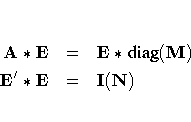EIGEN Call
computes eigenvalues and eigenvectors
- CALL EIGEN( eigenvalues, eigenvectors,
A)
<VECL="vl">;
where A is an arbitrary square numeric matrix
for which eigenvalues and eigenvectors are to be calculated.
The EIGEN call returns the following values:
- eigenvalues
- a matrix to contain the eigenvalues of the input matrix.
- eigenvectors
- names a matrix to contain the right eigenvectors of the input matrix.
- vl
- is an optional n ×n matrix containing
the left eigenvectors of A in the same
manner that eigenvectors contains the right eigenvectors.
The EIGEN subroutine computes eigenvalues,
a matrix containing the eigenvalues of
A arranged in descending order. If A
is symmetric, eigenvalues in the n ×1 vector containing
the n real eigenvalues of A.
If A is not symmetric (as determined by the criterion
described below) eigenvalues
is an n ×2 matrix containing the eigenvalues of the
n ×n matrix A. The first column
of A contains the real parts, Re( , and the
second column contains the imaginary parts Im
, and the
second column contains the imaginary parts Im .Each row represents one eigenvalue,
.Each row represents one eigenvalue,  .Complex conjugate eigenvalues, Re
.Complex conjugate eigenvalues, Re ,are stored in standard order; that is, the eigenvalue of
the pair with a positive imaginary part is followed by the
eigenvalue of the pair with the negative imaginary part.
,are stored in standard order; that is, the eigenvalue of
the pair with a positive imaginary part is followed by the
eigenvalue of the pair with the negative imaginary part.
The EIGEN subroutine also computes eigenvectors,
a matrix. If A is symmetric, then
eigenvectors has orthonormal column eigenvectors of
A arranged so that the matrices correspond;
that is, the first column of eigenvectors is the
eigenvector corresponding to the largest eigenvalue, and so forth.
If A is not symmetric, then
eigenvectors is an n ×n matrix containing
the right eigenvectors of A.
If the eigenvalue in row i of eigenvalues is real, then column
i of eigenvectors contains the corresponding real eigenvector.
If rows i and i+1 of eigenvalues contain complex
conjugate eigenvalues Re ,then columns i and i+1 of eigenvectors contain the real,
v, and imaginary,
,then columns i and i+1 of eigenvectors contain the real,
v, and imaginary,  , parts, respectively,
of the two corresponding eigenvectors
, parts, respectively,
of the two corresponding eigenvectors  .
.
The eigenvalues of a matrix A are the
roots of the characteristic polynomial, which
is defined as p(z) = det(zI- A).
The spectrum, denoted by  , is
the set of eigenvalues of the matrix A.
If
, is
the set of eigenvalues of the matrix A.
If  , then
, then
 .
.
The trace of A is defined by

and tr .
.
An eigenvector is a nonzero vector, x, that satisfies
 for
for  .
Right eigenvectors satisfy
.
Right eigenvectors satisfy  , and left
eigenvectors satisfy
, and left
eigenvectors satisfy  .
.
The following are properties of the unsymmetric
real eigenvalue problem, in which the real
matrix A is square but not necessarily symmetric:
- The eigenvalues of an unsymmetric
matrix A can be complex.
If A has a complex
eigenvalue
 , then the
conjugate complex value
, then the
conjugate complex value  is also an eigenvalue of A.
is also an eigenvalue of A.
- The right and left eigenvectors corresponding
to a real eigenvalue of A are real.
The right and left eigenvectors corresponding to conjugate
complex eigenvalues of A are also conjugate complex.
- The left eigenvectors of A are the same as the
complex conjugate right eigenvectors of A'.
The three routines, EIGEN, EIGVAL,
and EIGVEC, use the following test
of symmetry for a square argument matrix A:
- Select the entry of A with the largest magnitude:

- Multiply the value of amax with the square
root of the machine precision
 . (The value of
. (The value of  is the largest value
stored in double precision that, when added
to 1 in double precision, still results in 1.)
is the largest value
stored in double precision that, when added
to 1 in double precision, still results in 1.)
- The matrix A is considered unsymmetric
if there exists at least one pair of symmetric entries
that differs in more than
 ,
,

If A is symmetric, the
result of the statement
call eigen(m,e,a);
has the properties

that is,
-
E' = inv(E)
so that
-
A = E* diag(M)*E' .
The QL method is used to compute the
eigenvalues (Wilkinson and Reinsch 1971).
In statistical applications, nonsymmetric matrices for which
eigenvalues are desired are usually of the form E-1 H, where E and H are symmetric.
The eigenvalues L and eigenvectors
V of E-1H can be obtained
by using the GENEIG subroutine or as follows:
f=root(einv);
a=f*h*f';
call eigen(l,w,a);
v=f'*w;
The computation can be checked by forming the residuals:
r=einv*h*v-v*diag(l);
The values in R should be of the order of round-off error.
Copyright © 1999 by SAS Institute Inc., Cary, NC, USA. All rights reserved.



